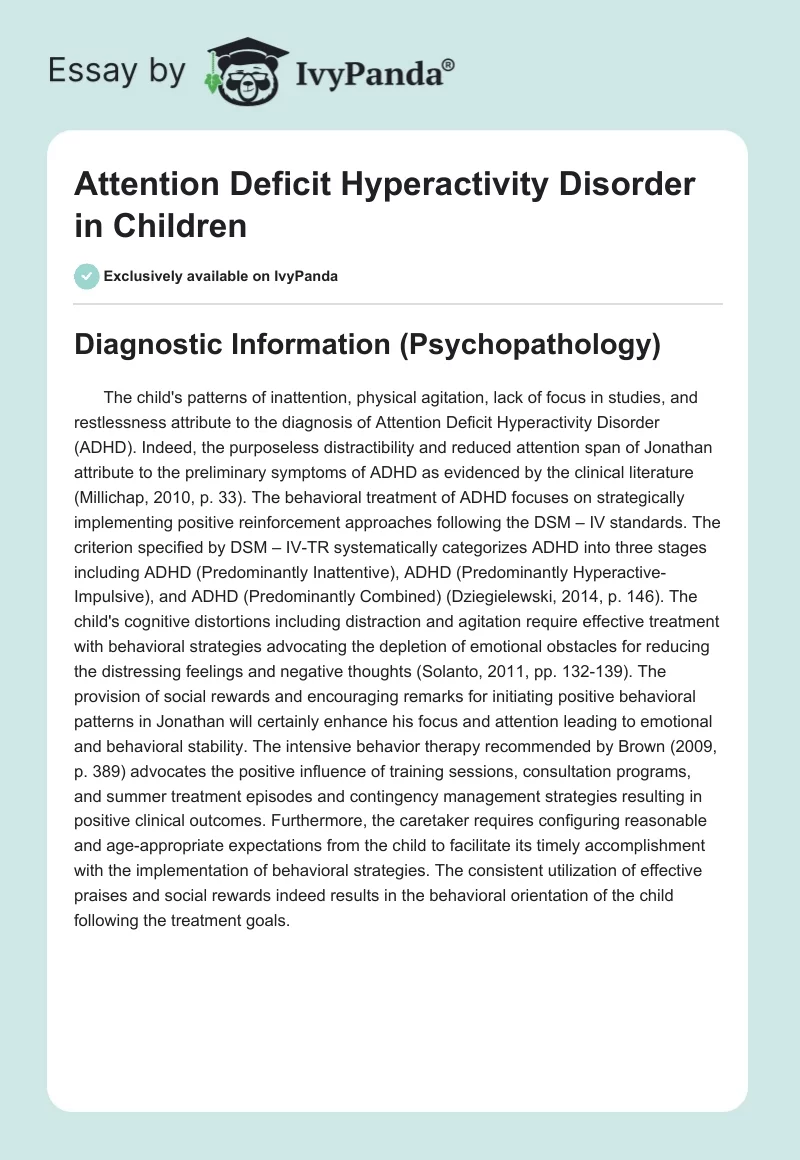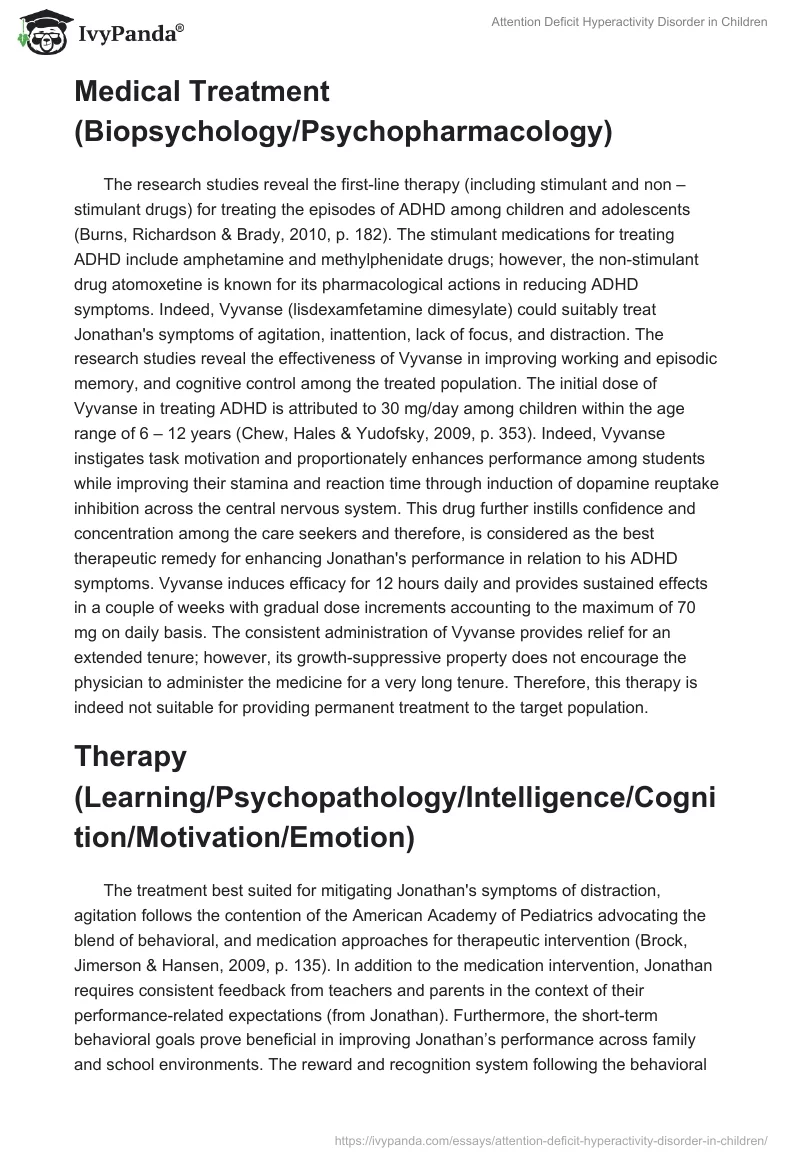- Diagnostic Information (Psychopathology)
- Medical Treatment (Biopsychology/Psychopharmacology)
- Therapy (Learning/Psychopathology/Intelligence/Cognition/Motivation/Emotion)
- Family Support (Developmental Psychology, Personality, Health & Stress)
- The Psychological Challenges & Community Support
- Conclusion
- References
Diagnostic Information (Psychopathology)
The child’s patterns of inattention, physical agitation, lack of focus in studies, and restlessness attribute to the diagnosis of Attention Deficit Hyperactivity Disorder (ADHD). Indeed, the purposeless distractibility and reduced attention span of Jonathan attribute to the preliminary symptoms of ADHD as evidenced by the clinical literature (Millichap, 2010, p. 33). The behavioral treatment of ADHD focuses on strategically implementing positive reinforcement approaches following the DSM – IV standards. The criterion specified by DSM – IV-TR systematically categorizes ADHD into three stages including ADHD (Predominantly Inattentive), ADHD (Predominantly Hyperactive-Impulsive), and ADHD (Predominantly Combined) (Dziegielewski, 2014, p. 146). The child’s cognitive distortions including distraction and agitation require effective treatment with behavioral strategies advocating the depletion of emotional obstacles for reducing the distressing feelings and negative thoughts (Solanto, 2011, pp. 132-139). The provision of social rewards and encouraging remarks for initiating positive behavioral patterns in Jonathan will certainly enhance his focus and attention leading to emotional and behavioral stability. The intensive behavior therapy recommended by Brown (2009, p. 389) advocates the positive influence of training sessions, consultation programs, and summer treatment episodes and contingency management strategies resulting in positive clinical outcomes. Furthermore, the caretaker requires configuring reasonable and age-appropriate expectations from the child to facilitate its timely accomplishment with the implementation of behavioral strategies. The consistent utilization of effective praises and social rewards indeed results in the behavioral orientation of the child following the treatment goals.
Medical Treatment (Biopsychology/Psychopharmacology)
The research studies reveal the first-line therapy (including stimulant and non – stimulant drugs) for treating the episodes of ADHD among children and adolescents (Burns, Richardson & Brady, 2010, p. 182). The stimulant medications for treating ADHD include amphetamine and methylphenidate drugs; however, the non-stimulant drug atomoxetine is known for its pharmacological actions in reducing ADHD symptoms. Indeed, Vyvanse (lisdexamfetamine dimesylate) could suitably treat Jonathan’s symptoms of agitation, inattention, lack of focus, and distraction. The research studies reveal the effectiveness of Vyvanse in improving working and episodic memory, and cognitive control among the treated population. The initial dose of Vyvanse in treating ADHD is attributed to 30 mg/day among children within the age range of 6 – 12 years (Chew, Hales & Yudofsky, 2009, p. 353). Indeed, Vyvanse instigates task motivation and proportionately enhances performance among students while improving their stamina and reaction time through induction of dopamine reuptake inhibition across the central nervous system. This drug further instills confidence and concentration among the care seekers and therefore, is considered as the best therapeutic remedy for enhancing Jonathan’s performance in relation to his ADHD symptoms. Vyvanse induces efficacy for 12 hours daily and provides sustained effects in a couple of weeks with gradual dose increments accounting to the maximum of 70 mg on daily basis. The consistent administration of Vyvanse provides relief for an extended tenure; however, its growth-suppressive property does not encourage the physician to administer the medicine for a very long tenure. Therefore, this therapy is indeed not suitable for providing permanent treatment to the target population.
Therapy (Learning/Psychopathology/Intelligence/Cognition/Motivation/Emotion)
The treatment best suited for mitigating Jonathan’s symptoms of distraction, agitation follows the contention of the American Academy of Pediatrics advocating the blend of behavioral, and medication approaches for therapeutic intervention (Brock, Jimerson & Hansen, 2009, p. 135). In addition to the medication intervention, Jonathan requires consistent feedback from teachers and parents in the context of their performance-related expectations (from Jonathan). Furthermore, the short-term behavioral goals prove beneficial in improving Jonathan’s performance across family and school environments. The reward and recognition system following the behavioral modification would motivate Jonathan in accomplishing the clinical goals in the shortest possible interval. Indeed, the patterns of intelligence among children affected with ADHD do not exhibit any direct impact on the progression of the disease. The patients with increased intelligence levels continue experiencing inattention and distraction leading to underachievement, irrespective of their intelligence quotient (Kooij, 2013, p. 41). Indeed, Jonathan does not prove problematic for peers and family members and continues displaying curiosity and academic accomplishment during the initial months at school. Therefore, he does have the instincts and motivation for resuming normal behavior.
Family Support (Developmental Psychology, Personality, Health & Stress)
Brown (2009, p. 318) reveals the family history of substance abuse and other comorbidities among family members in established cases of ADHD. The disrupted relationships with parents and caretakers affected with substance abuse adversely affect the behavior of children affected with ADHD. Ryan and McDougall (2009, p. 81) reveal the patterns of behavioral disorientation among children affected by disorganized attachments with their family members. Indeed, the support extended by the patient’s family members through effective counseling and coping strategies potentially assists the child affected with ADHD in overcoming behavioral instability. The expenses incurred in utilizing treatment therapy and psychological counseling indeed financially affect the patient and his family members. Furthermore, Jonathan’s family requires clinical assistance for understanding the patterns of ADHD and effective coping strategies in supporting him in mitigating the behavioral outcomes. The personality traits exhibited by Jonathan attribute to decreased willpower, predisposition to developing other psychological manifestations, decreased listening skills, and instincts related to overlooking the details, thereby resulting in performance errors. The patterns of stress indeed, add up to the clinical manifestations of Jonathan in an ADHD set.
The Psychological Challenges & Community Support
The research studies reveal the psychological challenges attributed to frustration and anger among ADHD patients that aggravate further under the influence of family and school environment (Plotnik & Kouyoumdjian, 2014, p. 31). Jonathan’s agitation increases under the work constraints imposed by his teacher in his school environment. The evidence-based academic literature reveals the assistance extended by CHADD (Children and Adults with Attention Deficit Disorders) to the patients of ADHD and their families in effective mitigation of the patterns of clinical manifestations (Rief, 2005). These social organizations extend support structures for ADHD patients while configuring long and short-term goals in treating the functional difficulties experienced in the community environment.
Conclusion
The cultural perspectives profoundly influence the patterns of ADHD among the affected children. The other multiple factors attributing to the development of ADHD include the conditions of infection, poor nutrition, substance abuse, toxicity, and hereditary and cultural factors in the community setting. The patients affected by ADHD may exhibit dangerous influences on themselves as well as the society; however, the treatment approaches are affected by the cultural, historical, and psychosocial outlook in the community environment. The best remedial strategies in treating ADHD among children include the blend of therapeutic and behavioral therapies and family counseling for mitigating the clinical outcomes. Indeed, the behavioral modification among ADHD patients induced with effective family training results in enhanced psychosocial outcomes. Furthermore, enhancement of social skills and cognitive abilities also influence the positive outcomes among ADHD patients in the community environment.
References
Brock, S.E., Jimerson, S.R., & Hansen, R.L. (2009). Identifying, Assessing, and Treating ADHD at School. New York: Springer.
Brown, T.E. (2009). ADHD Comorbidities: Handbook for ADHD Complications in Children and Adults. USA: American Psychiatric Publishing.
Burns, C., Richardson, B., & Brady, M. (2010). Pediatric Primary Care Case Studies. USA: Jones & Bartlett.
Chew, R.H., Hales, R.E., & Yudofsky, S.C. (2009). What Your Patients Need to Know about Psychiatric Medications (2nd ed). USA: American Psychiatric Publishing.
Dziegielewski, S.F. (2014). DSM-IV-TR in Action: Includes DSM-5 Update Chapter (2nd ed). New Jersey: Wiley.
Kooij, J.J.S. (2013). Adult ADHD: Diagnostic Assessment and Treatment. London: Springer – Verlag.
Millichap, J.G. (2010). Attention Deficit Hyperactivity Disorder Handbook: A Physician’s Guide to ADHD. New York: Springer.
Plotnik, R., & Kouyoumdjian, H. (2014). Introduction to Psychology. USA: Wadsworth – Cengage.
Rief, S.F. (2005). How To Reach And Teach Children with ADD / ADHD: Practical Techniques, Strategies, and Interventions (2nd ed). USA: Jossey – Bass.
Ryan, N., & McDougall, T. (2009). Nursing Children and Young People with ADHD. New York: Routledge.
Solanto, M.V. (2011). Cognitive-Behavioral Therapy for Adult ADHD: Targeting Executive Dysfunction. New York: Guiltford.


